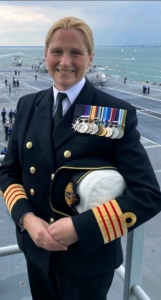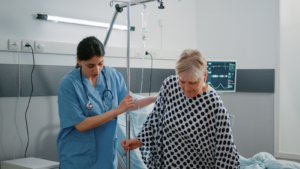Congress Newsletter 2022
Lessons from the front line – preview Sir Robert Macintosh lecture 2022

This year’s Sir Robert Macintosh Lecture will be given by Kate Prior, who is Surgeon Captain in the British Royal Navy and also a Consultant in Anaesthetics and Major Trauma, at King’s College Hospital, London, UK. She will deliver her perspectives on serving as an anaesthesiologist in conflict zones, as well as other important experiences from outside this environment
Q: Welcome to Euroanaesthesia 2022 Kate. For our delegates that don’t know you, please tell us a bit about yourself, including where you are currently based.
A: I’m a consultant anaesthetist in the Royal Navy. I work at King’s College Hospital in London when I’m not away with the Navy. I’m also a trauma team leader and I do that at St Marys Hospital, London.
Q: You have the honour of delivering this year’s Sir Robert Macintosh lecture, on ‘Lessons from the Front Line’. Never has this topic been more relevant than today, with Russia’s invasion of Ukraine. Where have you served on the frontline?
A: In recent years, my operational military role has taken me to war in Afghanistan and Iraq, the humanitarian response in Sierra Leone during the Ebola crisis and working for the United Nations in South Sudan. Last year, I was the Clinical Director of the Role 2 Afloat medical team embarked on the aircraft carrier, HMS QUEEN ELIZABETH, for the Carrier Strike Group deployment.
Q: The anaesthesiologist’s role can be challenging enough in normal hospital conditions – but to imagine doing so in conflict zones and facing multiple casualties with multiple injuries is daunting. What kind of training do you and other front line doctors have to face these situations – and can any training really prepare you for the reality?
A: Whilst simulation and training exercises are very good for understanding the process, promoting teamwork and effective communication, I don’t think any training truly prepares for the realities of war and for managing such severely injured patients.
Q: Please could you talk us through some of the situations faced by the anaesthesiologists (and other medical personnel) on the frontline. How much of your work is done ‘there and then’, and how much of it is about providing vital stabilising procedures to help those injured reach a treatment facility?
A: Two of my three operational tours in Afghanistan were as the doctor on the Medical Emergency Response Team (known as the MERT). The team flew out to the frontline in a Chinook helicopter to collect the most severely injured casualties and start the treatment process en route back to the hospital at Camp Bastion. We were essentially a flying emergency department staffed with a doctor, emergency nurse and two paramedics able to provide advanced interventions: haemorrhage control, anaesthesia, blood transfusion, thoracostomies and high-quality analgesia.
Q: Tell us about some of your proudest moments serving on the front line. Of course, while any war is a dire situation, you must really feel part of a team trying to do something incredible.
A: It was the best of times, it was the worst of times to misappropriate the opening line of “A Tale of Two Cities” by Charles Dickens. I think any member of Her Majesty’s Armed Forces who experienced a deployment to Afghanistan to support UK troops and our allies on Operation HERRICK will remember the highs of saving a life and the absolute lows when we couldn’t. It’s not often in my normal NHS work as a consultant anaesthetist working in a major trauma centre that I actually save a life or that someone does their very best to die on me. Afghanistan was exactly that multiple times a day, day in and day out.
Whilst this was the most challenging medicine I’ve ever done, it was also some of the most rewarding and it was a joy to be part of a well-trained and high functioning team all working with one common cause and prepared to learn lessons from every patient – to save life.
Thank you Kate for sharing some of these experiences with us, and we look forward to your full lecture today.
Read More of our special newsletter covering our congress.










